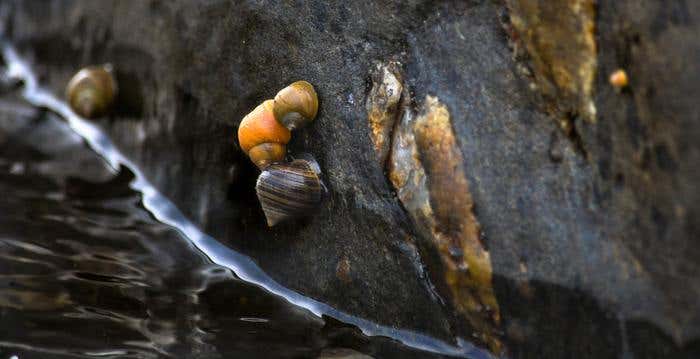Researchers reveal the incredible secrets of evolutionary change
In the ever-evolving world of biology, the question of how major evolutionary leaps occur has long perplexed scientists.

[Jan. 10, 2024: JD Shavit, The Brighter Side of News]
Littorina snails are common on the rocky shores of Europe, the UK, and the East Coast of the USA. (CREDIT: Daria Shipilina)
In the ever-evolving world of biology, the question of how major evolutionary leaps occur has long perplexed scientists. While we've witnessed the emergence of remarkable adaptations like flight, vision, and live offspring bearing, the mechanisms behind these transformative changes have remained a mystery.
Do they happen suddenly, like a bolt from the blue, or do they unfold gradually over time? This enduring debate may have found an answer, thanks to a groundbreaking study by biologists from the University of Sheffield, in collaboration with researchers from the University of Gothenburg and the Institute of Science and Technology Austria.
Evolutionary processes are typically characterized by slow, incremental steps, where small changes accumulate over generations. However, occasionally, nature produces extraordinary innovations that seemingly defy this gradual progression. For instance, the development of feathers paved the way for birds to take flight, but how did such complex adaptations come to be?
Until recently, understanding these significant evolutionary shifts was a formidable challenge. The enigma lies in their antiquity, as many of these transformations occurred in the distant past.
Related Stories
Additionally, visualizing the intermediate stages of these developments proved elusive. Some theories proposed that these leaps resulted from large-effect mutations that gave rise to what were whimsically termed 'hopeful monsters.' Others argued that innovations were crafted through a gradual, step-by-step process, with natural selection favoring intermediary forms.
Enter marine snails, an unlikely but crucial player in solving this evolutionary puzzle.
These unassuming creatures, through a recent shift from egg-laying to live-birth, provided a unique opportunity for scientists to probe the nature of evolutionary transitions.
The researchers used a novel methodology to investigate whether this transition happened abruptly or unfolded progressively. Their findings could potentially shed light on other dramatic shifts in the world of evolution.
Adult snails adapted to different habitats. The larger snail is adapted for defense against crab attacks, while the small snail is adapted to live in areas with strong wave exposure. (CREDIT: Sophie Webster)
The study identified a set of 50 genes intricately linked to reproductive modes and estimated the time of their origin. The results were revelatory, showcasing a gradual accumulation of these genes over time, each spreading at distinct points in history. This breakthrough demonstrates that major innovations can indeed evolve progressively, rejecting the idea of a single, monumental evolutionary leap.
Professor Roger Butlin, hailing from the University of Sheffield's School of Biosciences, emphasized the significance of understanding the origins of key innovations. He stated, "The evolutionary origin of key innovations is important to understand because they can dramatically change the course of evolution, like when live-bearing led to the diversification of mammals or feathers helped birds to evolve flight. Until now, however, there have been few opportunities to study these, mainly because most evolutionary changes happened so long ago."
Live-bearing has allowed Littorina snails to occupy and adapt to a diverse range of habitats. This has led to the evolution many ‘ecotypes’ that vary in their size, shape and behavior. (CREDIT: Fredrik Pleijel)
Butlin further elaborated, "By discovering and studying the recent evolutionary shift in the way marine snails give birth, we're now able to understand these major changes and apply our methods to many other evolutionary shifts." This research opens up a new perspective for biologists, shifting the focus from grand, sudden leaps in evolution to the gradual benefits accrued through small, incremental steps.
The next phase of the research aims to delve deeper into the functions of the identified genes. By doing so, scientists hope to unravel the series of evolutionary steps that led to live birth in these marine snails. Moreover, they aspire to apply their innovative methods to a broader spectrum of adaptations, including traits crucial for survival in a changing world, such as thermal tolerance in the face of climate change.
Littorina snails are common on the rocky shores of Europe, the UK, and the East Coast of the USA. (CREDIT: Daria Shipilina)
The progressive nature of these innovations challenges our conventional understanding of evolution, highlighting the pivotal role played by small steps in shaping the diversity of life on Earth. As our world continues to change, this research offers hope for understanding how various species might adapt to the challenges of the future.
The study titled "The genetic basis of a recent transition to live-bearing in marine snails" was published within the journal Science.
For more green news stories check out our Green Impact section at The Brighter Side of News.
Note: Materials provided above by The Brighter Side of News. Content may be edited for style and length.
Like these kind of feel good stories? Get the Brighter Side of News' newsletter.
Joshua Shavit
Science & Technology Writer | AI and Robotics Reporter
Joshua Shavit is a Los Angeles-based science and technology writer with a passion for exploring the breakthroughs shaping the future. As a contributor to The Brighter Side of News, he focuses on positive and transformative advancements in AI, technology, physics, engineering, robotics and space science. Joshua is currently working towards a Bachelor of Science in Business Administration at the University of California, Berkeley. He combines his academic background with a talent for storytelling, making complex scientific discoveries engaging and accessible. His work highlights the innovators behind the ideas, bringing readers closer to the people driving progress.



